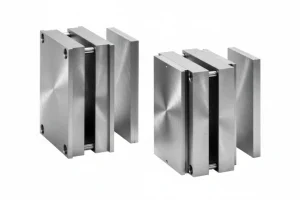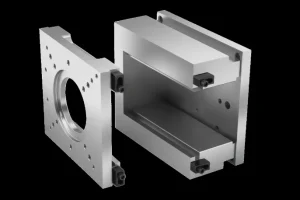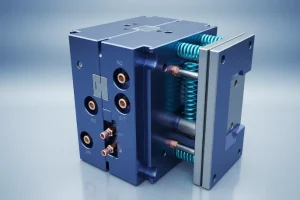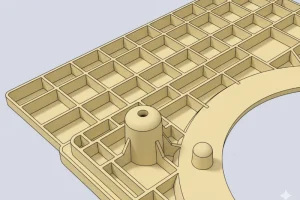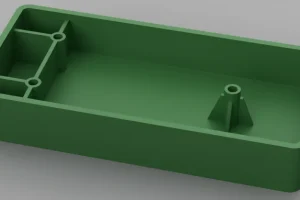Two-plate injection molding machines are a fundamental component of the manufacturing industry, enabling efficient production of plastic parts through a straightforward yet effective mechanism.
Two-plate injection molding machines simplify mold design with a single clamping mechanism, ideal for large, flat plastic parts. They are cost-effective, easy to maintain, and suit simple product designs.
While two-plate injection molding machines offer simplicity and cost benefits, understanding their limitations and use cases is essential for optimizing production efficiency. Delve deeper to learn how these machines can be integrated into your manufacturing processes.
Two-plate injection molding machines offer a simpler design than three-plate machines.True
Two-plate machines feature a single parting line, streamlining the mold design and reducing complexity compared to three-plate systems.
Two-plate injection molding machines are ideal for highly complex parts.False
These machines are better suited for simpler designs as their mold opens with a single parting line, limiting their capability for complex shapes and geometries.
What is the Definition of a Two-Platen Injection Molding Machine?
Two-platen injection molding machines offer a more compact and versatile approach to mold clamping, which enhances efficiency and adapts to various manufacturing needs.
Two-platen injection molding machines have a compact design without tie bars, offering flexibility and efficiency in producing large parts, especially in space-constrained environments.

As the name implies, the two-platen injection molding machine1 consists of two main boards: the moving plate and the fixed plate. The moving plate is used to open and close the mold, and the fixed plate is used to fix the mold. The two-platen injection molding machine is easy to operate, has a relatively simple structure, and has strong adaptability. It is widely used in the injection molding industry.
A two-plate injection molding machine uses a 2 plate mold, which is one of the most common mold designs in injection molding. Unlike three-plate molds, which include an additional runner plate for improved gating options, two-plate molds have a simpler design with only a single parting surface. This same parting surface facilitates easier mold construction and maintenance.
In the two-plate mold design, the runner system2 is typically located within the mold cavity itself. Hot runner mold, which integrate a heated runner system to keep the plastic molten, can also be used in two-plate molds. The runner system directs the molten plastic into the mold cavities to form the desired injection molded product
Three-plate mold, or 3 plate mold, incorporate an intermediate or cavity plate along with a runner stripper plate to allow for more complex gating and part ejection. These molds are especially useful for producing parts that require intricate details and high precision.
Both two-plate and three-plate mold3 use ejector pin to remove the finished product from the mold. The choice between a two-plate injection mold and a three-plate injection mold depends on the specific requirements of the part being produced and the complexity of the mold design needed.
Two-platen machines save space compared to three-platen machines.True
The two-platen design eliminates the need for a third platen, reducing the overall machine footprint and allowing for installation in smaller manufacturing spaces.
Two-platen machines cannot handle complex molding tasks.False
Two-platen machines are versatile and can effectively manage complex and large molding tasks, thanks to their advanced clamping and precision capabilities.
What is the History And Development of a Two-Platen Injection Molding Machine?
Two-platen injection molding machines have evolved to offer improved efficiency and flexibility, meeting the demands of modern industries with their space-saving and robust designs.
Two-platen injection molding machines, with a compact design, enhance precision and energy efficiency, making them ideal for large parts in automotive and appliance industries by improving clamping force accuracy.

The history of two-platen injection molding machines can be traced back to the middle of the 20th century. At first, the injection molding machines were relatively simple and had a limited scope of use. However, with the advancement of mechanical technology and the unlimited growth of the market, the two-platen injection molding machine has now developed into an efficient and precise plastic molding tool.
Early Development
Early two-platen injection molding machines were manufactured using mechanical transmission systems, which were cumbersome to operate and had low production efficiency. The introduction of hydraulic technology has greatly improved the performance of injection molding machines.
Introduction of Hydraulic Systems
Hydraulic systems were extensively used in the injection molding machines in the 1960s to improve the control accuracy and clamping force. Hydraulic two-plate injection molding4 machines were literally the quickly penetrating products of the market.

Application of Computer Control Systems
Later in the 1980s the computer technology was introduced in the injection molding machines and with this the best control of the injection molding was made possible. Two-plate injection molding machines of this period offered higher production rate and quality of the product.
Intelligent and Automated Development
Entering the 21st century, concepts such as Industry 4.05 and intelligent manufacturing have gradually gained popularity, leading injection molding machines to develop towards intelligence and automation. The latest double-plate injection molding machines are equipped with advanced sensors and control systems, including mechanisms such as diagnosable, self-adjustable, and self-repairing.
Two-platen machines save space on the factory floor.True
Their compact design requires less floor space compared to traditional three-platen machines, ideal for maximizing production area.
Two-platen machines are suitable only for small scale production.False
These machines are designed to handle large-scale production with high clamping forces, suitable for industries like automotive and heavy appliances.
What is the Structure of a Two-Platen Injection Molding Machine?
Two-platen injection molding machines are vital for efficient production, offering space-saving solutions and enhanced performance in various industrial applications.
A two-platen injection molding machine, ideal for automotive and appliance manufacturing, features a compact design with two platens, reducing energy use and footprint while offering precision and efficiency for large, complex molds.
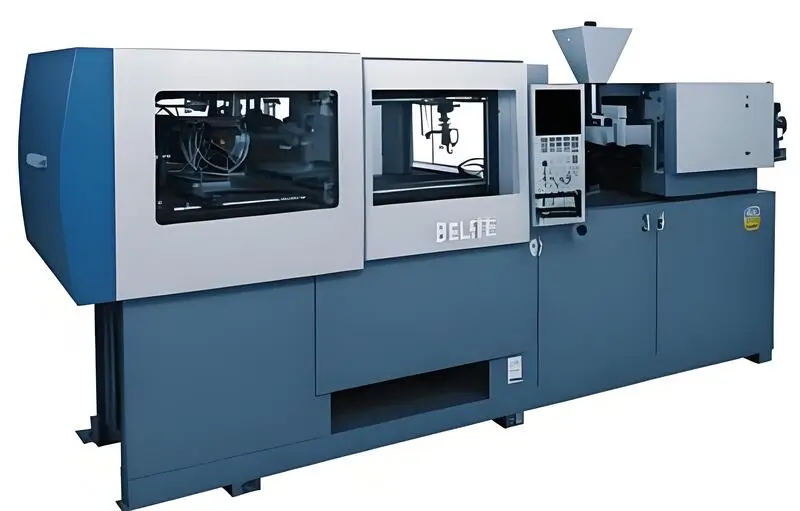
The structure of a two-plate injection molding machine mainly includes the following components:
Injection System
The injection system of the double-plate injection molding machine is responsible for heating and melting the plastic particles and injecting them into the mold. The system usually consists of a hopper, a heating cylinder, a screw and a nozzle.
-
Hopper: Stores plastic particles and then pumps them into the heating cylinder.
-
Heating Barrel: Heats the plastic particles until they melt, and the heating process is usually electrically heated.
-
Screw: Rotates inside the heating cylinder, pushes the molten plastic forward, and then shoots it out of the nozzle into the mold.
Mold System
Mold System is a mechanical system made from the moving platen and fixed platen with mold that is mounted on them. The mold is closed and opened by the moving platen, while the fixed platen holds the mold in place.

-
Moving Platen: Hydraulic/electrical operated, which means it is used to open or close the mold.
-
Fixed Platen: Attached to the injection molding machine, does not move when opening and closing of the mold is performed.
Clamping System
The clamping system6 offers enough clamping force to ensure that the mold does not open during the injection process. The clamping system of a two-plate injection molding machine is usually operated by hydraulic means.
- Clamping Force: Force exerted by the hydraulic cylinders to maintain the mold with a closed type for injection.
Hydraulic System
The injection molding machine and the clamping system are powered by a hydraulic system7. The hydraulic system includes an oil pump, a hydraulic cylinder, a hydraulic valve, etc., which converts hydraulic energy into mechanical energy.
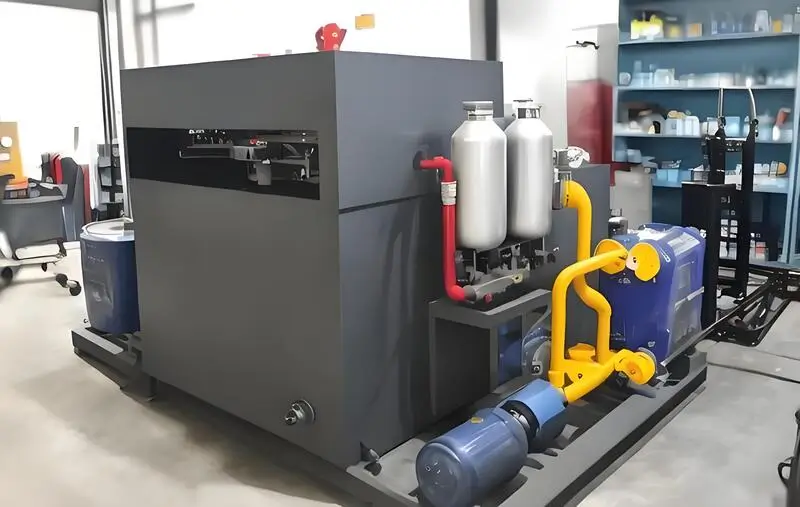
Control System
The control system plays a very strategic role in the two-plate injection molding machines as it is everywhere in charge of commanding several aspects of the injection molding process. The contemporary two-plate injection units predominantly employ computerised control systems which are precise and effective.
Drive System
The drive system includes motors, transmission devices, and other such elements which are used to supply the power for other operating components in the injection molding machine.
Cooling System
The current cooling system8 usually uses cooling water or other cooling media to remove heat from the mold and the internal parts of the injection molding machine to ensure the stability of the production process and the quality of the product.
Two-platen machines always offer higher efficiency than three-platen machines.False
While two-platen machines have a compact design, the efficiency depends on application requirements. Three-platen machines may be better suited for certain productions.
Two-platen machines reduce the footprint compared to traditional designs.True
The elimination of the third platen results in a more compact machine, offering better use of floor space.
What is the Working Principle of a Two-Platen Injection Molding Machine?
Two-platen injection molding machines offer a compact design and efficient production solutions, benefiting various manufacturing sectors.
Two-platen injection molding machines feature a simplified clamping system for enhanced space efficiency and reduced setup time, offering consistent pressure distribution suitable for large, complex parts and versatile designs.

The working principle of a two-plate injection molding machine can be summarized in the following steps:
Feeding
The pellets of plastic is filled in to the hopper, moving in response to the rotating screw, the pellets are pushed forward and melted by heat.
Injection
The melted plastic is pushed forward by the screw and injected into the mold cavity through the nozzle. At this time, the mold is in a closed state.
Holding Pressure
After the molten plastic is injected into the mold, the injection molding machine applies a holding pressure to prevent the melt from flowing back and maintain the density and strength of the product.
Cooling
In the mold cavity, the plastic cools and solidifies to form the desired product shape. The choice of cooling time is affected by the thickness of the product and other characteristics of the material.
Mold Opening
After cooling, the moving platen withdraws and the mold opens up, the product is ejected.
Product Removal
The operator or a robotic arm removes the product from the mold, completing the entire injection molding cycle.
Two-platen machines enhance space efficiency in manufacturing setups.True
Their compact design requires less floor space, allowing more flexibility in factory layouts.
Two-platen injection molding machines are less precise than traditional machines.False
These machines offer accurate clamping force distribution, enhancing precision and consistency in parts production.
What are the Advantages And Disadvantages of a Two-Platen Injection Molding Machine?
Two-platen injection molding machines offer streamlined clamping mechanisms that enhance flexibility and production capabilities, benefiting diverse industries.
Two-platen injection molding machines offer reduced footprint, enhanced flexibility, energy savings, and better mold alignment, ideal for automotive and large-part applications with higher precision and shorter cycle times.

Advantages
-
Simple Structure:Generally speaking, the characteristics of the two-platen injection molding machine are simple structure and easy operation and maintenance. Since the movable platen and the fixed platen are designed to accommodate and operate the mold, they can adapt to various molds.
-
Lower Cost:The two-platen injection molding machine has low manufacturing and maintenance costs. Therefore, it is popular with many small and medium-sized enterprises because it helps avoid expensive upfront cost investment.
-
Strong Adaptability: The two-plate injection molding machine is versatile when it comes to the types of plastics as well as the products since it is widely used in different industries. Thus, from a common thermoplastic to some special plastics, the two-plate injection molding machine can accommodate it.
-
Short Production Cycle: The production cycle9 of the two-plate injection molding machine is relatively short because of the simplicity of the system; therefore, the injection molding process can be completed quickly.
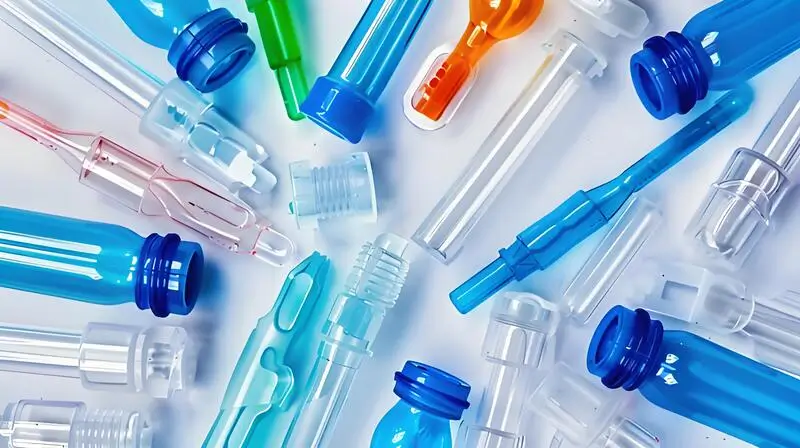
Disadvantages
-
Limited Clamping Force: Due to design limitations, the clamping force of the two-plate injection molding machine is relatively low, thus not suitable for high clamping force application10.
-
Lower Efficiency: Compared with some high-end multi-platen injection molding machines, the production efficiency of two-platen injection molding machines may also be relatively low. In large-scale production, the efficiency of two-platen injection molding machines may not be excellent.
-
Difficulty in Molding Complex Products: For complex shape and precision structure of products, these two-plate injection molding machines may have some limitations on the molding process so that it may be further require some additional process control or some other kinds of injection molding machines.
Two-platen machines always provide better energy efficiency.False
While two-platen machines can offer energy savings, their efficiency depends on various factors including machine size and application requirements.
Two-platen injection molding machines enhance mold alignment.True
The design of two-platen machines provides better symmetry and reduced deflection, improving mold alignment and quality of produced parts.
What are the Application Areas of a Two-Platen Injection Molding Machine?
Two-platen injection molding machines offer advantages in space-saving and energy efficiency, making them ideal for various high-precision manufacturing sectors.
Two-platen injection molding machines, favored in automotive, electronics, and packaging industries, offer a compact design enabling high precision and large part production, with key benefits of space efficiency and energy savings.

Two-plate injection molding machines are widely used in various industries, mainly including:
Automotive Industry
Two-plate injection molding machines are widely applied to making car components like dashboard, door trim, bumper, etc. , which always demands high accuracy and smooth surface, which two-plate injection molding machines can meet.
Electronics and Electrical Industry
In electronics and electrical industry, the two-plate injection molding machines are applied for the manufacturing of Every kinds of plastic housings, plugs, sockets and so on. These products need high dimensional accuracy and the service life of the automobiles, which can be provided by the high-precision injection system of two-plate injection molding machines.
Household Goods Industry
The areas related to two-plate injection molding machines are also very wide in the home appliances industry such as making plastic furniture, kitchen utensils, daily use articles, etc. Since many of these products need smooth external look and reasonable inside structure, which is provided by the good working performance of the two-place injection molding machines.
Medical Device Industry
Two-plate injection molding machines that are widely employed in the medical device industry includes the following manufacture medical instruments, housings, among others. These products demand high material safety and accuracy in carrying out the required process that can be provided by the precision control system of two-plate injection molding machines.

Packaging Industry
The packaging industry has a large demand for plastic products, such as plastic bottles, containers or packaging boxes. Due to its high working efficiency and high molding precision, the two-platen injection molding machine is more widely used in this regard.
Construction Industry
Two-plate injection molding machines are employed for manufacturing plastic pipes, fittings, doors, windows, etc in the construction industries. These products need high strength and good durability, from this perspective, two-plate injection molding machines are able to produce high-quality products to fulfill these demands.
Two-platen machines are more compact than traditional three-platen machines.True
Their compact design allows for a smaller footprint, which is beneficial for production facilities with space constraints.
Two-platen machines are suitable only for small-scale productions.False
They are capable of handling large-scale production runs and are used in industries requiring large parts, like automotive and packaging.
Conclusion
Playing a major role in the injection molding process11, the two-plate injection molding machine is recognized as a versatile equipment adopted in different industries mainly because of its simple design, ease of operation as well as high flexibility in use. With development of new technologies and enhancements continually, two-plate injection molding machines would be smarter, more efficient, energy saving, multifunctional and environmental friendly, which will intensify the opportunities and challenges to the injection molding industry.
Learning for the working principle, advantages, disadvantage, and application field of two-plate injection molding machines is beneficial for mastering this kind of essential equipment, enhancing the production efficiency of products, and ensuring sustainable development of the whole industry.
-
Explore the benefits of two-platen injection molding machines, including efficiency and adaptability, to enhance your understanding of modern manufacturing. ↩
-
Learn about Everything You Need to Know about Cold Runner System in Injection Molding:What is the Injection Molding Process?Cold runner systems operate by allowing the plastic to cool in the runner channels. ↩
-
Learn about the functionality of three-plate molds and their advantages in producing complex parts with high precision. ↩
-
Explore the benefits of two-plate injection molding to understand its efficiency and suitability for various applications. ↩
-
Learn how Industry 4.0 is revolutionizing manufacturing, including automation and smart technologies in injection molding. ↩
-
Discover the critical role of the clamping system in ensuring the integrity and efficiency of the injection molding process. ↩
-
Understanding the hydraulic system’s role in injection molding can improve your insights into machine efficiency and performance. ↩
-
Learn about the cooling system’s critical role in maintaining product quality and production stability in injection molding processes. ↩
-
Learn about the production cycle in injection molding to optimize your manufacturing efficiency and reduce costs. ↩
-
Exploring the significance of high clamping force can enhance your knowledge of injection molding processes and their applications. ↩
-
Learn about How to Optimize an Injection Molding Process?What is the Injection Molding Process? Injection molding is the process of making semi-finished parts of a certain shape by pressurizing, injecting, cooling, and separating the molten raw materials. ↩



